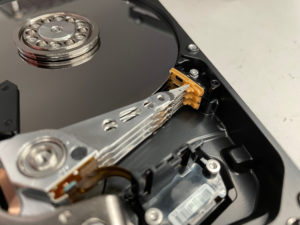
The read/write heads of a hard drive in a resting position.
A hard drive voice coil is a type of linear motor consisting of a coil of wire suspended within a strong magnetic field. When an electrical current passes through the coil, it interacts with the magnetic field, generating a force that causes the coil to move.
In the context of a hard drive, this movement translates to the positioning of the read/write heads across the surfaces of the platters (thin discs coated in magnetic material).
- The voice coil itself is typically made of copper wire and is wound around a lightweight former.
- The magnetic field is generated by powerful permanent magnets positioned around the coil.
- The coil is attached to the actuator arm, which in turn holds the read/write heads.
When a current is applied to the voice coil, it experiences a force that causes it to move linearly within the magnetic field. The direction and magnitude of this force can be controlled by varying the current flowing through the coil. This allows the read/write heads to be precisely positioned over any desired track on the platter.
What can go wrong with a hard drive voice coil?
The read/write heads must be positioned with micron-level accuracy to ensure that data is read and written correctly. The voice coil, in conjunction with a sophisticated control system, allows for this exceptional level of precision, enabling the heads to track the rapidly spinning platters and access the required data tracks
While the voice coil is a remarkably reliable component, it’s not immune to issues that can impact a hard drive’s functionality.
- Overheating and Burnout: The voice coil operates in a high-performance environment, and excessive heat can damage the coil’s insulation or even cause it to burn out. This often leads to erratic head movement or complete failure of the actuator mechanism.
- Physical Damage or Misalignment: A shock or impact to the hard drive can damage the delicate voice coil or cause it to become misaligned within the magnetic field. This can result in inaccurate head positioning and difficulty reading or writing data.
- Wear and Tear: Over time, the constant movement of the voice coil can lead to wear and tear, particularly in high-performance drives with frequent head movements. This can result in decreased accuracy and potential data corruption.
Data recovery specialists can sometimes compensate for wear by adjusting firmware settings or utilizing other advanced data extraction techniques. Otherwise, engineers might attempt to repair or replace the damaged coil in a cleanroom environment to regain access to the data.
Voice Coils vs. Stepper Motors
Voice coils are the prevalent technology for modern hard drives, but that wasn’t always the case; older models used stepper motors, which consisted of multiple coils arranged around a central rotor with toothed poles.
By energizing specific coils in sequence, the rotor is attracted to different magnetic poles, causing it to rotate in precise angular increments or steps. In hard drives, this rotational motion is converted into linear movement of the actuator arm through gears or belts.
The first voice coils required complex control systems, while stepper motors were simpler — but that simplicity translated to severe performance limitations. Voice coils allow for faster seek times and data transfer rates, and given the extraordinary areal density of modern hard drives, voice coils are practically indispensable.
A Trusted Resource for Professional Data Recovery
Datarecovery.com provides an expert resource for hard drive data recovery. With expedited and 24/7 options, we help you restore files from any HDD or SSD — and with our no data, no charge guarantee, you don’t pay for unsuccessful recovery attempts.
To learn more, submit a case online or call 1-800-237-4200 to speak with an expert.




